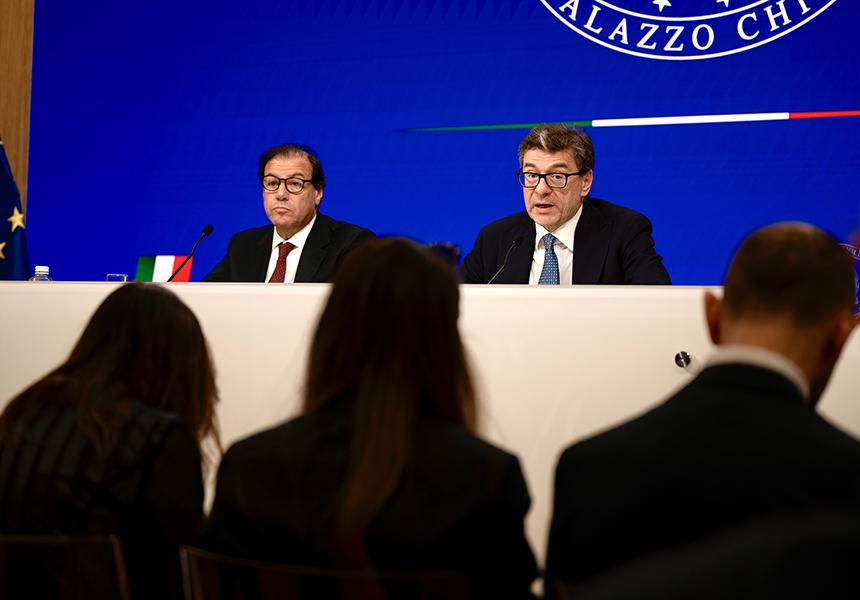What is the Def like (and how much rubbish has been written)

What is and what is not (rightly) in the Economic and Financial Document approved by the Council of Ministers. Giuseppe Liturri's analysis
It took about an hour for the Council of Ministers to give the green light to the Economic and Financial Document, an essential step in the long liturgy (European Semester) wanted by Brussels to control and coordinate the public finances of the member states.
There are few surprises, despite the fact that since Sunday all the main newspapers in the country have been writing in (almost) unified networks, with often scandalized tones, about the "frozen" Def, because it lacks the programmatic part. That is, the public finance numbers that the government in office intends to achieve as a result of new rules introduced during the year. Minister Giancarlo Giorgetti limited himself to publishing the data of the trend framework, i.e. those that are the result of the currently approved regulations, without new interventions.
According to Federico Fubini in Corriere della Sera last Sunday, " postponing the presentation of the programmatic framework therefore allows the government not to make known the sacrifices necessary to manage the debt at least until after the European elections in June" .
An instrumental reading of a fact that is not at all relevant – on which rivers of ink were however wasted for two days – for at least two reasons.
The first is that it made no sense to publish a policy direction when the public finance framework for 2025 will be the result of a negotiation with the next Commission. The reform of the Stability Pact in fact requires governments to negotiate with the Commission a "technical trajectory" defined by two parameters: the growth of net public spending and the change in the structural primary surplus. Over a 4 or 7 year time horizon, each year will have a target and deficit/GDP and debt/GDP will be reduced thanks to the achievement of those targets. What was the point of publishing a programmatic part when in a few weeks' time we will have to think within a completely new perimeter, the contours of which not even the Commission knows in a definitive way?
The second reason is even more structural. In April it is very unlikely that a government will be excessively unbalanced on the public finance picture for the following year. In fact, in September it is always up to Nadef to outline the objectives for the following year which, after a few weeks, are detailed in the budget plan document sent to Brussels and in the bill sent to the Chambers for the budget session. In April no one turns over their cards. Let's be clear, in the past governments have almost always published a programmatic part in April as well. But those data made sense especially on the occasion of corrective measures for the current year, the programmatic part has always been a pro-forma, waiting for September.
Having clarified this non-trivial procedural aspect, we come to the data disclosed by Giorgetti relating to the trend picture. GDP growth in 2024 is forecast at +1%, against +1.2% in the latest Nadef and this is already good news, because all the main forecasting centers do not go beyond 0.8% (Bankitalia + 0.6%).
The deficit/GDP for 2024 is confirmed at 4.3% and is expected to reach 3% only in 2026.
All in all, the effect of the Superbonus expenditure on the public debt is limited compared to the Nadef. It is true that the debt/GDP ratio goes from 137.3% in 2023, to 137.8%, 138.9%, 139.8%, respectively for 2024, 2025 and 2026.
But it should be noted that last September the debt-to-GDP for 2026 was planned at 139.6%. Almost at the same level as the new forecast, despite there being tens of billions of Superbonuses that have sprung up like mushrooms in the last six months.
Furthermore, given the previous forecast errors, it is to be hoped that this time the MEF technicians have refined the estimates, err on the side of caution.
The only programmatic element revealed by Giorgetti is that relating to the desire to continue with the cut of the tax wedge also in 2025: "the decontribution which expires in 2024, we absolutely intend to replicate it in 2025, this is the real objective we set ourselves when we go to define the structural program,” he declared.
Another important element is that – now topical – of the extension of the deadline for completing the PNRR investments, scheduled for the first half of 2026. Giorgetti declared that " I have already asked for an extension in Europe: they advised me against it, so I I insist. I don't know if you realized that after the approval of the Pnrr a war broke out in Europe. In Brussels I wouldn't want it to be done like in Rome, where the extension is decided the day before", instead it would be preferable to decide well in advance also "to ease tension and pressure on prices". «I am the Minister of Economy, Gentiloni is the commissioner, Lagarde is the governor of the central bank: can I express my hope, is it blasphemy? Among fellow ministers we all say this to each other, the commission remains firm, who knows, maybe the next one will evaluate differently".
Our readers have been reading about the impossibility of executing that plan (war or not) for about 3 years. Finally Giorgetti too has come to terms with reality.
This is a machine translation from Italian language of a post published on Start Magazine at the URL https://www.startmag.it/economia/come-il-def-e-quante-fesserie-sono-state-scritte/ on Tue, 09 Apr 2024 14:40:06 +0000.
